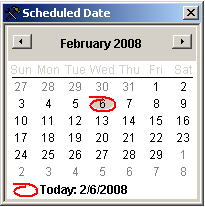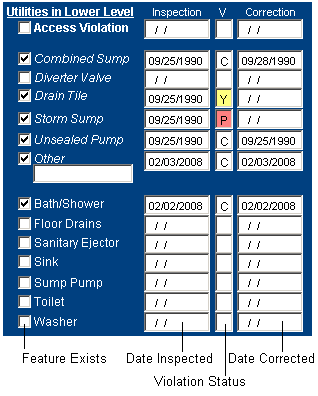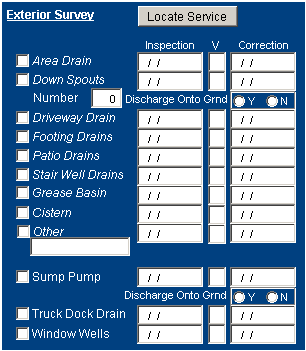 Inflow and Infiltration
Inflow and Infiltration
 Inspections
Inspections
Called from INI Main, Additional Information Tab
Much of the data entry on this form is point and click, with extensive use of right click methods and double clicks. You can tab through the fields or click into them to enter text. Read through this section before entering an inspection. Top of screen:

Contact Name: Often the contact person for an inspection is not the property owner / resident. It may be a realtor or contractor. If you do not enter a contact name the system will warn you (though it is not a mandatory field) when you save the inspection.
Contact Phone: Same rules as Contact Name.
Inspection Type: This drop-down field is mandatory. You can add, delete or modify these types using the administrator functions.
Date Inspected: This is the date the actual inspection occurred. This field is not mandatory if the Scheduled Date is filled in. Double click on this field to bring up an interactive calendar. Select the date and click the X at the top right corner of the calendar to close the calendar. The date you selected, signified by shading around the date, will be entered into the date field. A red circle around the date indicates today. If you choose not to keep the date you can double click to launch the calendar again or you can highlight the date field and press Ctrl+Y to empty the field.

Scheduled Date: Most I and I inspections are requested in advance by a property owner or their representative. If you did not enter an Inspection Date you should enter the Scheduled Date. Double click for the calendar.
Time: This is the scheduled Time for the upcoming inspection. Enter this information as 0000PM/AM. Do not enter the colon or spaces. The system will format your entry for you.
Inspector: You will be warned if you do not select an Inspector. It is not mandatory because you may not know who will be assigned the inspection until it goes to the field. The Inspectors are entered through the administrative functions.
Date Closed: Sometimes an inspection will be concluded (no violation found is an example, or violations found and corrected in the same visit) on the day of the inspection. Sometimes return visit(s) are required. When all violations are corrected then the inspection can be Closed. Double click for the calendar.
Notes: The big box under the above fields are for field notes. There is a 1,000 character limit to how much you can enter into the Notes field.
The remainder of the screen captures details about each of the property OutFlow features. This section is broken into two column groups, Interior and Exterior survey. The interactive functions for each group are the same. On the left are the Interior features, usually referred to as Utilities in Lower Level.

The first column of checkboxes indicate whether or not a feature exists in the interior or exterior of the structure. If you are just indicating that the feature exists then click the box to check it off. Click the box again to uncheck it. If the existence of a feature is confirmed by an inspection then you do not have to click this box. It will be updated when you go through the Inspection Builder.
The Inspection Builder fills in and marks the appropriate fields for you. To activate it double click on the inspection date field to the right of the feature. The builder will:
Violation field. The boxes in this column denote the result of an inspection of a feature. The possible results are blank, Y, P and C. The box is blank by default. Y means Yes there was a noted violation. P means there is a Potential violation. C means there was a violation and it was Corrected. Entering these results can be accomplished by pressing the appropriate key on the keyboard (Y,P,C). You can cycle through the choices by repeatedly pressing the space bar or by clicking on the field.
Color Coding. The violation field is color coded according to status. Blank and Corrected have a standard white background. If the value of the violation field is Y, for Yes there is a violation, the background of the box is light red. If it is P, for Potential, the background is yellow.
Potential Violation Warning. If you mark. The violation field as P then each time you pull up that inspection on the screen a reminder will pop up listing the potential violation(s). This persists until the value of the violation field is changed. Presumably this state is an indication that further review or Testing is in order, perhaps a Dye Test, to determine if there is in fact a violation.
Additional Data Integrity measures are programmed into the system to help avoid conflict. If you change the violation field to C, and the Correction Date is empty, then the system asks if you want to enter a Correction Date. If you enter a correction date and the violation field holds a value other than C then the system changes the violation to C. If you enter a Correction Date and the Inspection Date field for that feature is empty the system asks if you want to copy the correction date value to the inspection date field.
Adding any information on a feature also checks the first checkbox indicating that, upon inspection, the feature was found to be present.
Other: If you enter information on a feature not listed on this screen the system remembers that feature. This user added feature can be further defined using the administrative function of the system. Always enter text that describes a feature in the box below the word Other.
The Exterior Survey operates in an identical fashion to the Interior Survey.

There are some additional fields in this section.
Down Spouts: Number: How many Down Spouts were identified. Discharge Onto Grnd: Do any of them discharge onto the surface.
External Sump Pump: Discharge Onto Grnd: If there is such a pump identified does it discharge onto the surface.

Link to Dye Test. There are two Link buttons. These buttons will bring up a screen that lets you view and / or schedule Tests. If a test has been scheduled or conducted you can see the results. If needed, you can enter a new test request to schedule Dye Testing, without leaving the inspection screen. The top Test button links a Dye Test to the Inspection record you are currently viewing. The Test button at the bottom of the screen is used to directly link a Test to a specific found Violation.

Note: Entering a new Dye Test from this Inspection screen does not provide all of the functions available in the direct Dye Test screen. The Dye Test screen, available from the Additional Information Tab, has functions that allow you to link to an inspection, add violation tickets and transfer (paste) notes from the Dye Test to the Inspection.
Click here to view information on this feature.
Save. Click the disk icon to save.

When you Save an Inspection Form the system will perform a variety of data integrity checks and the Inspection will be added to your database. **Also see information on the Service Module.
At the bottom of the screen is a list of actual Violation Tickets that are associated with the results of this Inspection.

The above buttons are self-explanatory. You may Add, Edit or Delete Violation details.
Locate Service

If you have installed the Service / Work Order component of Viking Works then this button allows you to locate a Service Request in that system. Sometimes an inspection can be triggered by a call by a citizen concerning a problem that, in turn, generated a Request for Service (a Work Order). This button brings up a list of Service Requests that have been entered for this address and lets you choose which one, if any, is related to this inspection. If you click this button and do not choose a service request record you will be asked if you want a new Service Request created in the Viking Works system.